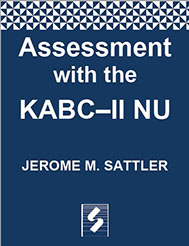|
|
JEROME M. SATTLER, PUBLISHER, INC. |
|||
|
COMPLETE TABLE OF CONTENTS
Chapter 1. KABCII NU 1 Subtests and Scales 4 Dual Theoretical Models 6 Standardization 7 Scale Scores, Scaled Scores, and Age Equivalents 8 Reliability 12 Validity 14 Intercorrelations Between Subtests and Scales 16 Factor Analysis 16 Range of Subtest Scaled Scores and Index Scores 24 Introduction to the 18 KABCII NU Subtests 25 1. Atlantis 27 2. Conceptual Thinking 28 3. Face Recognition 29 4. Story Completion 31 5. Number Recall 32 6. Gestalt Closure 34 7. Rover 35 8. Atlantis Delayed 37 9. Expressive Vocabulary 38 10. Verbal Knowledge 39 11. Rebus 41 12. Triangles 42 13. Block Counting 44 14. Word Order 45 15. Pattern Reasoning 47 16. Hand Movements 48 17. Rebus Delayed 49 18. Riddles 51 Interpreting the KABCII NU 52 Strengths of the KABCII NU 54 Limitations of the KABCII NU 54 Concluding Comment on the KABCII NU 55 Thinking Through the Issues 55 Summary 55 Key Terms 60 Study Questions 61
Chapter 2. Topics in Assessment 63 Definitions of Intelligence 64Theories of Intelligence 64 WISCV 64 Canadian WISCV 68 WPPSIIV 70 WJ IV COG 70 Ravens Progressive Matrices 70 Fluid Intelligence and Crystallized Intelligence 70 Executive Functions, Intelligence, and Education 71 Intelligence, Adaptive Behavior, and Autism Spectrum Disorder 73 ADHD, Intelligence, and Working Memory 74 Critical Thinking Skills 74 Cognitive Reserve and Brain Reserve 74 Speed of Information Processing and Intelligence 75 Rapid Automatized Naming and Reading Fluency 75 Lead Toxicity and Cognition 75 Children Born Preterm 75 Maternal and Paternal Age at Childbearing 76 Capital Punishment and IQ 76 IQ and Education 76 Life Outcomes and Intelligence 76 Thinking Through the Issues 78 Summary 78 Key Terms 81 Study Questions 81
Appendix A. Table for the KABC–II NU 83 A-1. Interpretive Rationales, Implications of High and Low Scores, and Instructional Implications for KABCII NU MPI, FCI, and NVI Global Scales 84A-2. Interpretive Rationales, Implications of High and Low Scores, and Instructional Implications for KABCII NU Specific Scales 95 A-3. Interpretive Rationales, Implications of High and Low Scores, and Instructional Implications for KABCII NU Subtests 104 A-4. Definitions of Broad and Narrow Abilities in the Cattell-Horn-Carroll (CHC) Model Associated with KABCII NU Subtests 112 A-5. Broad and Narrow Abilities in the Cattell-HornCarroll (CHC) Model Associated with KABCII NU Core and Supplementary Subtests 114 A-6. Broad and Narrow Abilities in the Cattell-HornCarroll (CHC) Model Associated with the KABCII NU Specific Scales 116 A-7. Broad and Narrow Abilities in the Cattell-HornCarroll (CHC) Model Associated with the KABCII NU MPI, FCI, and NVI Global Scales 117 A-8. Suggested Abilities and Background Factors Associated with KABCII NU Subtests 118 A-9. Suggested Abilities and Background Factors Associated with KABCII NU Specific Scales 120 A-10. Suggested Abilities and Background Factors Associated with KABCII NU MPI, FCI, and NVI Global Scales 122 A-11. Administrative Checklist for the KABCII NU 124 A-12. Percentile Ranks for Standard Scores (SS) with Mean = 100 and SD = 15 135 A-13. Classification Ratings for Standard Scores on the KABCII NU 136 A-14. Percentile Ranks and Suggested Qualitative Descriptions for Scaled Scores with Mean = 10 and SD = 3 137
References 139 Name Index 143
|

